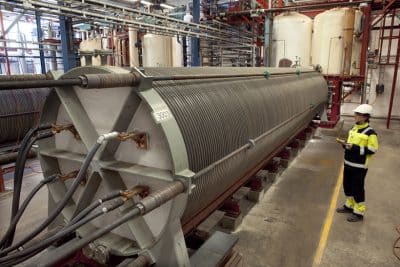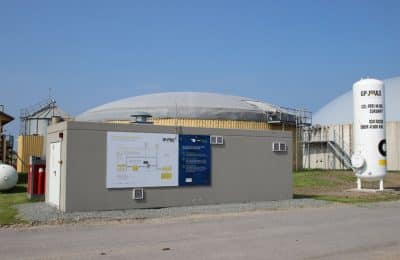Splitting water into hydrogen and oxygen with the help of electrical energy is commonly known as water electrolysis. This process matches the oxyhydrogen experiments one may remember from the classroom, albeit in reverse. If the anode and cathode in an electrolyzer cell are separated by a semipermeable membrane or a diaphragm, the gases produced by the process can be directed out of the cell individually.
Due to the rising share of electricity generated from renewable sources and the subsequent transformation of energy supply, hydrogen production has gradually assumed a much more prominent role. As an electrochemical process, water electrolysis makes it possible to couple power generation with other energy-relevant industries (power-to-X concept).
Hydrogen or its derivatives produced from renewably sourced electricity can be used as storage media for renewable energy. They are not limited to being chemical substances, but can be found as a secondary energy carrier in stationary and mobile applications in several industries and markets.
The successful increase of the renewable share in Germany over the last 15 years and stronger government support have led to several German stakeholders becoming (co-)leaders in researching, developing and demonstrating the benefits of water electrolysis around the globe. They have launched many power-to-gas – and since recently, power-to-liquid – projects (P2G and P2L; see fig. 2). [1]
Technology trends
There are three relevant water electrolysis methods today: AEL, alkaline electrolysis using a liquid base electrolyte; PEMEL, acid-based electrolysis with a proton exchange membrane and a solid polymer electrolyte; and SOEL, high-temperature electrolysis with solid oxide as the electrolyte.
Particularly alkaline electrolyzers with liquid electrolytes, operated at around 80 °C, have been in commercial use for over 100 years (see fig. 1). In the mid-twentieth century, there were some electrolyzer systems with up to 140 MW and the hydrogen they generated was primarily used as a chemical element in fertilizer production. These modules are still available today. They are offered at below 10 MW, a cell surface area of up to 3 m² and can often be operated at ambient pressure. Modified versions of these modules are increasingly used for P2G applications.
…
More recent developments in alkaline electrolysis often come in compact size and integrated into standard containers (see fig. 4). They are mostly operated at between 10 and 20 bars of pressure. Current advancements put less of a focus on cell surface area, operating pressure or temperature, but on increasing the current density from today’s around 0.2 to 0.4 A/cm² to about 1 A/cm² in order to lower specific capital costs. This increase is said to be achieved through using electrochemically more active electrodes, optimizing combinations of bipolar plates and electrodes (see fig. 3) and improved electrolyte management. One challenge of development is to retain a lifetime equal to conventional cell materials in alkaline electrolysis despite more complex catalyst systems and greater current density.
…
In the last 20 years, PEM electrolysis has become an established means of energy production primarily for industrial or niche applications requiring up to around 10 Nm³ per hour, high operating pressure and an operating temperature of around 60 °C. In principle, they can be combined with renewable energies (fast startup and shutdown, can be operated at intermediate load or absorb excess energy, able to handle high pressures while sporting a compact design, option to operate at differential pressure, etc.), which has led to considerable R&D efforts in almost all countries over the last ten years, both in industry and research institutions. One activity that was and still is the focus of development is the scale-up of cell surface area and, consequently, an increase in stack power.
Whereas the niche applications mentioned above typically had up to 200 cm² of cell surface, current modules in the low-megawatt category use cells with an active surface area of 600 to 1,500 cm² (see fig. 5).
…
High-temperature units
The current domain of high-temperature steam electrolysis continues to be the R&D stage. Individual cell stacks have a rating in the lower kilowatt range. The operating temperature typically is between 750 and 1,000 °C. The high working temperatures make it possible to operate the stacks in both fuel cell and electrolysis mode. This is also being touted as a benefit by the few suppliers and developers of solid oxide electrolysis cells. Consequently, nearly all SOEC developments are based on fuel cell materials from the SOFC and they may simply be adapted for electrolysis operation. Flat cell designs are clearly favored over tubular ones (see also fig. 6).
…
Despite the growing importance of electrolysis for intersectoral integration of the energy industry, there has only been a small, commercial market for water electrolyzers. Around the globe, one can find only few, mostly small businesses offering products in this segment. Besides established uses in industry, such as hydrogen production in power plants to cool generators, renewable storage remains a nascent market. Often, there is also a lack of sustainable business models to ensure commercial viability.
Table 1: List of selected electrolyzer manufacturers; data from 2017
…
As seen in the table, many of the systems have indeed been commercially available around the globe. However, it should be noted that most manufacturers only produce them in small series or on demand.
Author: Dr. Tom Smolinka




























0 Comments